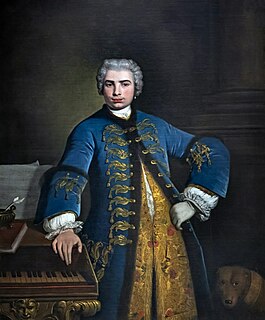
Farinelli was the stage name of Carlo Maria Michelangelo Nicola Broschi, a celebrated Italian castrato singer of the 18th century and one of the greatest singers in the history of opera. Farinelli has been described as having soprano vocal range and sang the highest note customary at the time, C6.

Senesino was a celebrated Italian contralto castrato, particularly remembered today for his long collaboration with the composer George Frideric Handel.

Pietro Antonio Domenico Trapassi, better known by his pseudonym of Pietro Metastasio, was an Italian poet and librettist, considered the most important writer of opera seria libretti.

Johann Adolph Hasse was an 18th-century German composer, singer and teacher of music. Immensely popular in his time, Hasse was best known for his prolific operatic output, though he also composed a considerable quantity of sacred music. Married to soprano Faustina Bordoni and a great friend of librettist Pietro Metastasio, whose libretti he frequently set, Hasse was a pivotal figure in the development of opera seria and 18th-century music.

Opera seria is an Italian musical term which refers to the noble and "serious" style of Italian opera that predominated in Europe from the 1710s to about 1770. The term itself was rarely used at the time and only attained common usage once opera seria was becoming unfashionable and beginning to be viewed as something of a historical genre. The popular rival to opera seria was opera buffa, the 'comic' opera that took its cue from the improvisatory commedia dell'arte.

Nicola (Antonio) Porpora was an Italian composer and teacher of singing of the Baroque era, whose most famous singing students were the castrati Farinelli and Caffarelli. Other students included composers Matteo Capranica and Joseph Haydn.
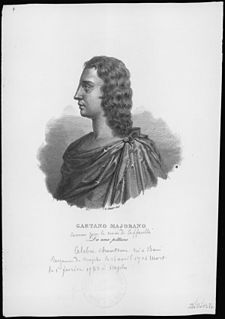
Gaetano Majorano was an Italian castrato and opera singer, who performed under the stage name Caffarelli. Like Farinelli, Caffarelli was a student of Nicola Porpora.
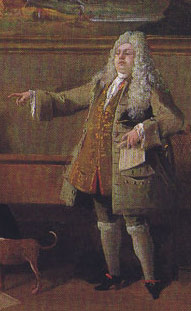
Nicolò Francesco Leonardo Grimaldi was an Italian mezzo-soprano castrato who is best remembered today for his association with the composer George Frideric Handel, in two of whose early operas he sang. Grimaldi was usually known by his stage name of Nicolini.

Arianna in Creta is an opera seria in three acts by George Frideric Handel. The Italian-language libretto was adapted by Francis Colman from Pietro Pariati's Arianna e Teseo, a text previously set by Nicola Porpora in 1727 and Leonardo Leo in 1729.

Artaserse is the name of a number of Italian operas, all based on a text by Metastasio. Artaserse is the Italian form of the name of the king Artaxerxes I of Persia.

Antonio Montagnana was an Italian bass of the 18th-century who is best remembered for his association with the composer George Frideric Handel, in whose operas Montagnana sang.

Marco Ricci was an Italian painter of the Baroque period.
Nicola Sabatino was a Neapolitan composer.
Filippo Amadei, also known as Pippo del Violoncello was an Italian composer from Reggio Emilia, who was active in Rome and London.

Domenico Annibali was an Italian castrato who had an active international career from 1725–1764. He began his career in his native country and was then committed to the Grosses Königliches Opernhaus in Dresden from 1729 until his retirement from the stage 35 years later. In Dresden he excelled in the operas of Johann Adolf Hasse, notably creating roles in the premieres of two of his operas. He was also admired there in works by Nicola Porpora.

Carlo Scalzi was an Italian castrato who had an active performance career in major opera houses in Italy from 1718-1738. He was also heard in London in 1733–1734 where he notably created the role of Alceste in the world premiere of George Frideric Handel's Arianna in Creta. The librettist Pietro Metastasio described Scalzi as a "very unique (sic) singer" and likened his voice to that of the famous castrato Farinelli.
Ezio is a baroque opera in three acts composed by Christoph Willibald Gluck, staged in 1750 and revised in 1763.
Ezio is an opera libretto by Pietro Metastasio, first officially set to music by Pietro Auletta and premièred in the Teatro delle Dame, Rome, on December 26, 1728; an unauthorized setting by Nicola Porpora had already been premièred a month earlier in Venice.
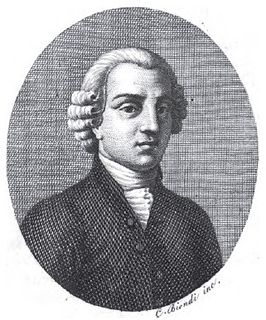
Sebastiano Biancardi, known by the pseudonym Domenico Lalli, was an Italian poet and librettist. Amongst the many libretti he produced, largely for the opera houses of Venice, were those for Vivaldi's Ottone in villa and Alessandro Scarlatti's Tigrane. A member of the Accademia degli Arcadi, he also wrote under his arcadian name "Ortanio". Lalli was born and raised in Naples as the adopted son of Fulvio Caracciolo but fled the city after being implicated in a bank fraud. After two years wandering about Italy in the company of Emanuele d'Astorga, he settled in Venice in 1710 and worked as the "house poet" of the Grimani family's theatres for the rest of his career. In addition to his stage works, Lalli published several volumes of poetry and a collection of biographies of the kings of Naples. He died in Venice at the age of 62.
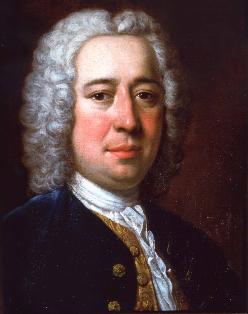
Arianna in Nasso is a 1733 opera by Nicola Porpora to a libretto by Paolo Rolli, chief conductor of the Opera of the Nobility. The choice of the subject of Ariadne was a challenge to Handel, whose Arianna in Creta was completed by 5 October 1733. Handel's Arianna in Creta was based on Pietro Pariati's much-set Arianna e Teseo, in the later of two versions by Leonardo Leo (1729). This was a libretto which Porpora himself had also used for his own Arianna e Teseo (1721). Handel's choice of libretto obliged Porpora to turn to Rolli's libretto which was modeled not on Pariati but on Stampa's libretto to Giovanni Porta's dramma pastorale, Arianna.















